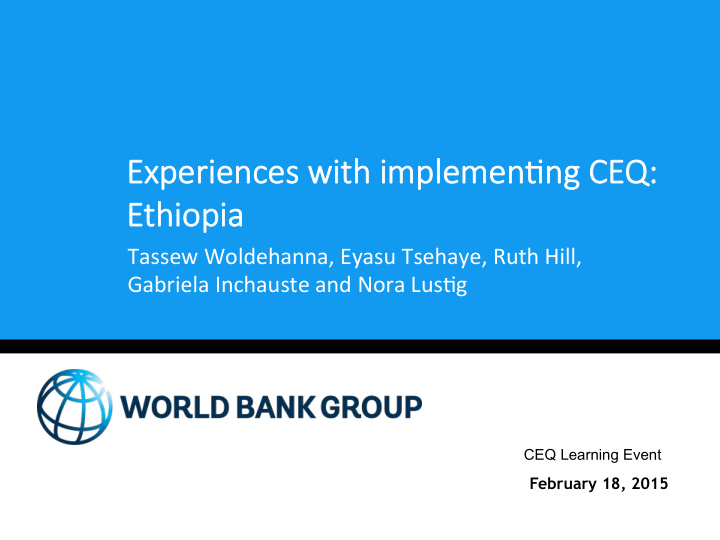



Experiences with imp mpleme men0ng CEQ: Q: Et Ethiopia Tassew Woldehanna, Eyasu Tsehaye, Ruth Hill, Gabriela Inchauste and Nora Lus<g CEQ Learning Event February 18, 2015
Outline • Context and mo<va<on for study • Main results • Dissemina<on and next steps 2
Context 3
Poverty has fallen quite rapidly in Ethiopia: the na<onal poverty rate fell by 33% since 2000 50 45 40 Poverty rate (headcount 35 index) 30 Depth of poverty 25 % (poverty gap 20 index) 15 Poverty severity 10 (squared poverty gap index) 5 0 2000 2005 2011 4
And there have been improvements in nutri<on, health, educa<on and access to services 5
Inequality is low and has remained so Gini coefficient in select countries in sub-Saharan Africa 6
And poverty has fallen faster in regions where poverty was highest Headcount poverty rate by region 7
The role of fiscal policy • The largest contributor to poverty reduc<on was growth, and in par<cular agricultural growth • What has been the role of fiscal policy? • A large share of public spending is devoted to pro-poor sectors, how effec<ve has it been in improving the financial posi<on of the poorest? • How can fiscal policy be improved to further reduce poverty and ensure shared prosperity? • Ethiopia has large public investment needs (infrastructure, basic service provision, safety nets) and there is limited fiscal space. Efficient, equitable fiscal policy is needed. • CEQ analysis prepared as part of the Ethiopia Poverty Assessment 8
Key findings 9
Direct taxes are low and a large share of tax revenue from indirect taxa<on Taxes as a share of GDP 30 25 20 Indirect taxes 15 Direct taxes 10 5 0 South Africa Brazil Mexico Ethiopia 10
But many poor households pay direct tax, as a result of small but prevalent rural taxes and limited progressivity in personal income tax Incidence of direct taxes by market income decile 11
And the poor pay a compara<vely large share of revenue, highligh<ng the challenge of revenue genera<on in a low income country Share of total taxes paid by socioeconomic group Source : Argentina: Lustig and Pessino 2014; Armenia: Younger et a., 2014; Bolivia: Paz et al. 2014; Brazil: Higgins and Pereira 2014; Indonesia: Jellema et al. 2014; Mexico: Scott 2014; Peru: Jaramillo 2014; South Africa: Inchauste et al. 2014; Uruguay: Bucheli et al. 2014; and Lustig (2014) based on Beneke et al, 2014 and Cabrera et al. 2014. For Ethiopia, own estimates based on HCES 2011. 12
Direct and indirect taxes are progressive, direct taxes more so Incidence of indirect taxes by Incidence of direct taxes by market income decile disposable income decile Source : Argentina: Lustig and Pessino 2014; Armenia: Younger et a., 2014; Bolivia: Paz et al. 2014; Brazil: Higgins and Pereira 2014; Indonesia: Jellema et al. 2014; Mexico: Scott 2014; Peru: Jaramillo 2014; South Africa: Inchauste et al. 2014; Uruguay: Bucheli et al. 2014; and Lustig (2014) based on Beneke et al, 2014 and Cabrera et al. 2014. For Ethiopia, own estimates based on HCES 2011. 13
Direct transfers—par<cularly those made through the large rural safety net—are well targeted and reduce poverty Impact of direct transfers Direct transfers as a share on poverty reduc<on of market income 35 30 25 20 15 10 5 0 Before transfers Aaer transfers Poverty rate (US$ 1.25 PPP) Poverty gap Poverty severity 14
But reduce poverty less than direct transfers in other countries, because less is spent on them Effec<veness of direct transfers Source : Argentina: Lustig and Pessino 2014; Armenia: Younger et a., 2014; Bolivia: Paz et al. 2014; Brazil: Higgins and Pereira 2014; Indonesia: Jellema et al. 2014; Mexico: Scott 2014; Peru: Jaramillo 2014; South Africa: Inchauste et al. 2014; Uruguay: Bucheli et al. 2014; and Lustig (2014) based on Beneke et al, 2014 and Cabrera et al. 2014. For Ethiopia, own estimates based on HCES 2011. Note : Poverty line of US$1.25 PPP is used for Ethiopia. For all the other countries the poverty line is US$2.5 PPP. 15
Public spending on educa<on and health is progressive; spending on primary educa<on and preventa<ve health care is pro-poor Incidence of health spending Incidence of educa<on spending by market income decile by market income decile Secondary Primary 16
Spending on subsidies is less progressive, and electricity subsidies are highly regressive 17
Subsidies are jus<fied as targeted to the urban poor; in aggregate they are but are small compared to transfers to rural households 18
Overall incidence of spending 19
Overall impact of fiscal policy: reduces poverty and inequality but at a cost to some who are poor • The poorest 80% Summary of fiscal incidence benefit from fiscal policy when all benefits are taken into account (solid black line) • However, some of the poorest do not benefit: 9% of households are impoverished—made poor or were poor and made poorer—by fiscal policy 20
Dissemina<on and next steps 21
Dissemina<on • The nature of the work is technical and poli<cally sensi<ve. • Closed door discussions have been important, more so than public dissemina<on, par<cularly when results have challenged exis<ng assump<ons, for example: • Many in the poorest deciles pay direct taxes. • The regressive nature of electricity subsidies, even among urban households. • Cross-country comparison have been par<cularly useful. • Areas of discussion: • Direct taxes: more progressive tax brackets. • The need for more efficient system of transfers in urban areas. • Regressivity of electricity subsidies 22
Next steps • Con<nued policy dialogue on exis<ng results • Analysis of the incidence of addi<onal important areas of public spending, e.g. agriculture, that require more assump<ons about the nature of externali<es • Government has requested this • Plan is to do this with our counterparts 23
Recommend
More recommend